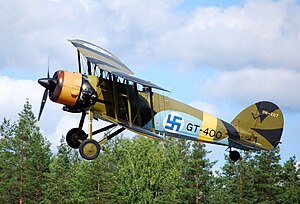| Gauntlet | |
|---|---|
 An ex-Finnish Air Force Gloster Gauntlet Mk II, GT-400, taking off at Selänpää Airfield, 2008 | |
| General information | |
| Type | Fighter |
| National origin | United Kingdom |
| Manufacturer | Gloster Aircraft |
| Primary users | Royal Air Force |
| Number built | 246 |
| History | |
| Manufactured | 1933–1936 |
| Introduction date | 1935 |
| First flight | 1933 |
| Retired | 1943 (U.K.) 1945 (Finland) |
| Developed from | Gloster S.S.18/19 |
| Variants | Gloster Gladiator |
The Gloster Gauntlet was a single-seat biplane fighter designed and produced by the British aeroplane manufacturer Gloster Aircraft in the 1930s. It was the last fighter to be operated by the Royal Air Force (RAF) to have an open cockpit, and also the penultimate biplane fighter in its service.
The Gauntlet had a somewhat lengthy development process, linking back to the S.S.18 prototype of 1929. Extensive modifications, including multiple engine changes and changes to suit varying specifications, resulted in a relatively fast fighter aircraft for the era as well as a heavy armament and favourable manoeuvrability. By mid-1933, the Gauntlet name had been applied to the type and the Air Ministry placed an initial order for 24 aircraft during September of that year. It was procured as a replacement for the Bristol Bulldog, being roughly 50 MPH faster while also being more heavily armed. In May 1935, No. 19 Squadron became the first unit to receive the Gauntlet I.
An improved model, the Gauntlet II, featuring structural improvements sourced from Gloster's new parent company, Hawker was developed during 1934; deliveries of this new model commenced in the following year. Gloster received orders for over 200 Gauntlet IIs, with the type eventually being operated by 14 RAF squadrons of RAF Fighter Command. It was used for various duties, including a secretive series of exercises that included the first interception of an aircraft using information relayed from ground-based radar, a technique that would prove to be vital during the Second World War. However, as early as 1936, frontline squadrons begun to be reequipped with more advanced fighters, such as the Gloster Gladiator, Hawker Hurricane and Supermarine Spitfire. Gauntlets were increasingly used in secondary roles and by overseas squadrons, serving in a reduced capacity into the Second World War. The last examples were withdrawn during 1943.